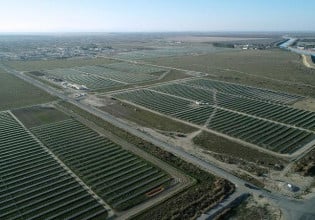Grid Stability: System Finds and Stops Wind Turbine Turbulence Effect
Researchers have developed a control system to localize and isolate malfunctions from forced oscillations to protect grid stability and manage wind farm performance.
Wind power technology is advancing as turbine towers evolve in size and scope, blade coatings become more sophisticated, and wind farm locations expand into the ocean and high-altitude mountainous regions. However, wind farms produce erratic changes in power outputs that can compromise grid stability. Natural fluctuations in wind velocity and forced oscillations can degrade equipment and jeopardize utility functionality.
A research team at the University of Birmingham, U.K., is pioneering a high-tech path for isolating and suppressing sudden power shifts due to forced oscillations. By controlling and localizing the impact, this tech offers a method for protecting system integrity and optimizing grid performance.
Wind farm in operation. Image used courtesy of the U.S. Department of the Interior
The Complexities of Rapid Wind Farm Growth
Like other renewable energy sectors, such as the electric vehicle market, the wind sector is also experiencing rapid growth. The Global Wind Energy Council recently updated its projection forecasts, which were already robust, to include a 13% increase in industry output amounting to 143 GW by the end of the decade.
Department of Energy’s report on wind power growth and projections beyond 2026. Image used courtesy of Lawrence Berkeley National Laboratory
The growth brings some fundamental complexities in engineering. Stronger and faster winds are the goldmine of the wind sector, and innovation is driving engineers into increasingly hostile environments to capture winds in the ocean and at high altitudes. Offshore wind farms are springing up across the globe, and taller turbines are being built in high-altitude locations, but in these more extreme environments, risks increase along with the wind speed.
Challenges of Forced Oscillations and Grid Stability
In hostile environments and more typical wind farm locations, wind turbulence and forces exerted from other sources (like wave turbulence in an ocean environment) can prove destructive for turbine equipment and wind farm operations.
Wake effect is one significant cause of forced oscillations. This occurs when the downstream turbines experience altered wind conditions due to the presence of upstream turbines. Wake effect can lead to uneven loading on turbine blades, resulting in oscillations in turbine rotation speeds and structural vibrations. Additionally, turbulent wind conditions, such as gusts and wind shear, can introduce abrupt airflow changes, causing fluctuations in turbine performance.
In offshore environments, the stress created by forces becomes increasingly complex as these forces are introduced from multiple directions and sources.
Multidirectional stress on offshore wind turbine structure. Image used courtesy of Nature
Dramatic changes in turbine performance can be multiplied across an entire wind farm; grid performance is threatened when turbines are synchronously connected to a utility grid. Power surges and supply lags can be equally problematic in operations and meeting electricity demand.
Controlling Forced Oscillations Through Isolation and Monitoring Transmission Lines
Damping technology is used to secure and stabilize turbine tower structures and lessen susceptibility to forced oscillations. Recent studies are particularly concerned with damping devices and offshore wind structures.
However, a better way to control and localize the dangerous impact of forced oscillations could be through software algorithms. These programs can track transmission lines and use dynamic monitoring to efficiently contain sudden disruptions in the power system. Professor Xiao-Ping Zhang at the University of Birmingham’s Department of Electronic, Electrical and Systems Engineering has been developing just such a control system to safely monitor a wide variety of wind farm formations.
Zhang’s control system helps a wind farm dynamically adjust its consumption and generation of active and reactive power, ultimately stopping the impact of forced oscillations from spreading throughout the power grid. The system is particularly advantageous because it does not require extra energy storage or the implementation of specific power electronic systems. In addition, it can be deployed without any previous data or understanding of the local forced oscillations’ frequency and strength, making it widely adaptable.
The research is based on simulations and a series of case studies. Researchers tested a variety of structures and arrangements to investigate performance across various wind farm dynamics as they relate to generators and utility grid operations.
The structure of a modified IEEE 39-bus power system used in the case studies. Image used courtesy of IEEE
As wind power becomes more central to the renewable energy transition, new solutions will be needed to minimize fluctuations in wind farm performance caused by forced oscillations. Critical technologies are under development to focus more on the dynamic monitoring of system power performance rather than fixating on individual turbine structures.










